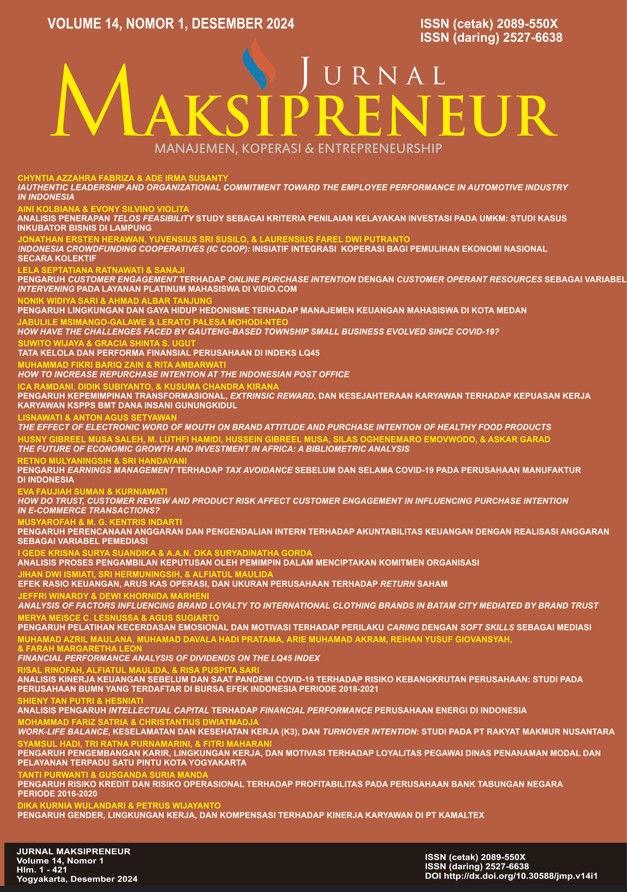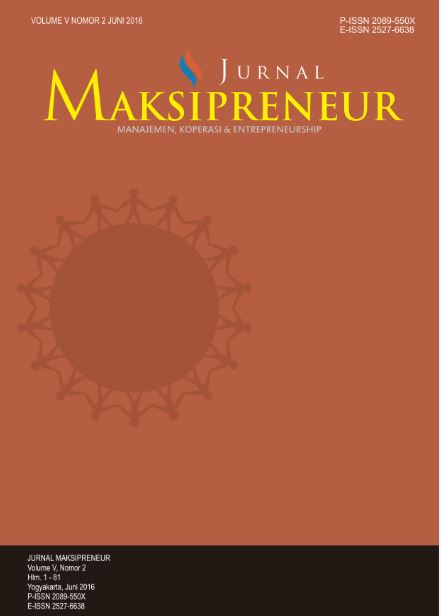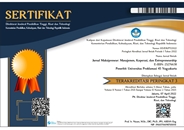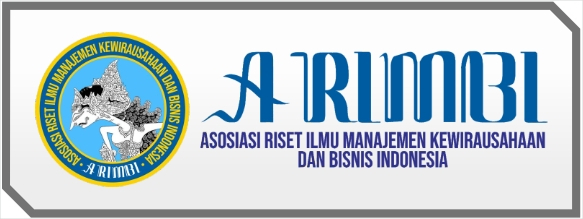How Do Trust, Customer Review and Product Risk Affect Customer Engagement in Influencing Purchase Intention in e-Commerce Transactions?
DOI:
https://doi.org/10.30588/jmp.v14i1.1869Keywords:
Customer Engagement, Customer Review, Product Risk, purchase intention., TrustAbstract
The numerous e-commerce platforms in Indonesia have driven the public to shift from conventional shopping to online transactions. The ease of use, product variety, and competitive pricing are reasons for the popularity of e-commerce. This study aims to determine the influence of Online Customer Review, Trust, and Product Risk on Purchase Intention, with Customer Engagement as a mediating variable in e-commerce transactions. The research is descriptive and quantitative, involving 221 respondents who have shopped via e-commerce platforms. The data analysis technique uses the Structural Equation Model AMOS 22 method. The results show that customer trust and reviews positively affect customer engagement and purchase intention. Additionally, customer engagement positively influences purchase intention. Lastly, product risk negatively affects purchase intention, although not significantly. The novelty of this research from the main journal is the addition of Customer Reviews as an independent variable that positively influences purchase intention and product risk as an independent variable that negatively affects purchase intention. The implication of this research suggests that online sellers should encourage customers to provide feedback on every purchase, thereby using customer reviews as an indirect promotional tool. Furthermore, product content should consider the perceived product risk by creating reliable content.
References
Abid, T., Abid-Dupont, M. A., & Moulins, J. L. (2020). What corporate social responsibility brings to brand management? The two pathways from social responsibility to brand commitment. Corporate Social Responsibility and Environmental Management, 27(2), 925–936. https://doi.org/10.1002/csr.1856
Adam, M., Ibrahim, M., Idris, S., Saputra, J., & Putra, T. R. I. (2022). An Investigation of E-Marketing and its Effect on the Consumer Buying Decision During Covid-19 Pandemic in Aceh Province, Indonesia: A Mediating Role of Perceived Risk. International Journal of Data and Network Science, 6(1), 115–126. https://doi.org/10.5267/J.IJDNS.2021.9.016
Adi, A. (2024). 5 E-Commerce dengan Pengunjung Terbanyak Sepanjang 2023. Databoks. https://databoks.katadata.co.id/datapublish/2024/01/10/5-e-commerce-dengan-pengunjung-terbanyak-sepanjang-2023
Alrawad, M., Lutfi, A., Almaiah, M. A., & Elshaer, I. A. (2023). Examining the Influence of Trust and Perceived Risk on Customers Intention to Use NFC Mobile Payment System. Journal of Open Innovation: Technology, Market, and Complexity, 9(2). https://doi.org/10.1016/j.joitmc.2023.100070
Alzahrani, J. (2019). The impact of e-commerce adoption on business strategy in Saudi Arabian small and medium enterprises (SMEs). Review of Economics and Political Science, 4(1), 73–88. https://doi.org/10.1108/REPS-10-2018-013
Anggraeni, D. A., Setiobudi, A., Teofilus, & Sandy, N. (2023). Analisis Kepercayaan dan Persepsi Risiko Produk terhadap Keputusan Pembelian Online di E-Commerce. Jurnal Bisnis, Manajemen, Dan Informatika (JBMI), 19(3), 160–175. https://doi.org/10.26487/jbmi.v19i3.1991
APJII. (2024). Jumlah Pengguna Internet Indonesia Tembus 221 Juta Orang. https://apjii.or.id/berita/d/apjii-jumlah-pengguna-internet-indonesia-tembus-221-juta-orang
Ariffin, S. K., Mohan, T., & Goh, Y. N. (2018). Influence of Consumers’ Perceived Risk on Consumers’ Online Purchase Intention. Journal of Research in Interactive Marketing, 12(3), 309–327. https://doi.org/10.1108/JRIM-11-2017-0100
Behnam, M., Anagnostopoulos, C., Byers, T., & Papadimitriou, D. A. (2023). The impact of perceived corporate social responsibility on value-in-use through customer engagement in non-profit sports clubs: the moderating role of co-production. European Sport Management Quarterly, 23(3), 789–810. https://doi.org/10.1080/16184742.2021.1929375
BPS. (2023). Indeks Pembangunan Teknologi Informasi dan Komunikasi 2022. Badan Pusat Statistik.
Cabeza-Ramírez, L. J., Fuentes-García, F. J., Cano-Vicente, M. C., & González-Mohino, M. (2022). How Generation X and Millennials Perceive Influencers’ Recommendations: Perceived Trustworthiness, Product Involvement, and Perceived Risk. Journal of Theoretical and Applied Electronic Commerce Research, 17(4), 1431–1449. https://doi.org/10.3390/jtaer17040072
Carlson, J., Rahman, M., Voola, R., & De Vries, N. (2018). Customer engagement behaviours in social media: capturing innovation opportunities. Journal of Services Marketing, 32(1), 83–94. https://doi.org/10.1108/JSM-02-2017-0059
Casado-Molina, A. M., Rojas-de Gracia, M. M., Alarcón-Urbistondo, P., & Romero-Charneco, M. (2022). Exploring the Opportunities of the Emojis in Brand Communication: The Case of the Beer Industry. International Journal of Business Communication, 59(3), 315–333. https://doi.org/10.1177/2329488419832964
Davis, F.D. (1989). Perceived usefulness, perceived ease of use, and user acceptance of information technology, graduate school of business administration. MIS Quarterly.
Dianari, G. (2018). The Impact of E-Commerce on Indonesia Economic Growth. Bina Ekonomi, 22(1), 43–62.
Direktorat Jenderal Bea dan Cukai. (2023). Modus Penipuan Online Shop Kian Marak, Ini Cara Pencegahannya. https://Www.Beacukai.Go.Id/Berita/Modus-Penipuan-Online-Shop-Kian-Marak-Ini-Cara-Pencegahannya.Html.
Duffett, R. G., & Charles, J. R. (2024). Assessing antecedents of Google shopping ads intention to purchase: a multigroup analysis of generation Y and Z. Young Consumers, 26(7), 1–21. https://doi.org/10.1108/YC-12-2023-1923
Duffett, R. G., & Maraule, M. (2023). Customer engagement and intention to purchase attitudes of generation Z consumers toward emojis in digital marketing communications. Young Consumers, 25(5), 607–624. https://doi.org/10.1108/YC-08-2023-1817
Ebrahim, R. S. (2020). The Role of Trust in Understanding the Impact of Social Media Marketing on Brand Equity and Brand Loyalty. Journal of Relationship Marketing, 19(4), 287–308. https://doi.org/10.1080/15332667.2019.1705742
Glaveli, N. (2020). Corporate Social Responsibility Toward Stakeholders and Customer Loyalty: Investigating the Roles of Trust and Customer Identification with the Company. Social Responsibility Journal, 17(3), 367–383. https://doi.org/10.1108/SRJ-07-2019-0257
Hadi, R. M., Februadi, A. C., & Gunawan, A. I. (2021). Analisis Persepsi Risiko dan Kepercayaan Konsumen dalam Belanja Online. Prosiding The 12th Industrial Research Workshop and National Seminar, Bandung, 4–5 Agustus.
Hair, J. F. J. (2021). Essentials of Marketing Reseach (fifth ed.). McGraw-Hill.
Hartini, S., Kurniawati, M., Sayyida, S., & Ihwanudin, M. (2022). Customer Review: Impact On Choice Confidence, Product Attitude, and Purchase Intention. Journal of Positive School Psychology, 6(8), 5977–5992.
Henry, K., Adiwijaya, M., & Subagio, H. (2023). Pengaruh Perceived Risk terhadap Purchase Intention dengan Mediasi Perceived Value dan Customer Attitude pada Pelanggan Online Shopping melalui Media Sosial Facebook di Surabaya. Petra Business & Management Review, 3(2), 62–83.
Kementerian Perdagangan RI. (2024). Kemendag Ramal Transaksi E-Commerce di RI Tembus Rp533 Triliun. https://www.kemendag.go.id/Berita/Pojok-Media/Kemendag-Ramal-Transaksi-e-Commerce-Di-Ri-Tembus-Rp533-Triliun.
Khan, S., Rashid, A., Rasheed, R., & Amirah, N. A. (2021). Designing a Knowledge-Based System (KBS) to Study Consumer Purchase Intention: The Impact of Digital Influencers in Pakistan. Kybernetes, 52(5), 1720–1744. https://doi.org/10.1108/K-06-2021-0497
Kharisma, H. P., Adiprasetya, K. M., Djohan, S. F., & Gunadi, W. (2022). Factors Influencing Online Video Advertising that Have an Impact on Brand Awareness, Brand Image, and Purchase Intention. Budapest International Research and Critics Institute-Journal (BIRCI-Journal), 5(2), 9171–9183. https://doi.org/10.33258/birci.v5i2.4705
Kim, J., & Lennon, S. J. (2013). Effects of reputation and website quality on online consumers’ emotion, perceived risk and purchase intention: Based on the stimulus-organism-response model. Journal of Research in Interactive Marketing, 7(1), 33–56. https://doi.org/10.1108/17505931311316734
Lăzăroiu, G., Neguriţă, O., Grecu, I., Grecu, G., & Mitran, P. C. (2020). Consumers’ Decision-Making Process on Social Commerce Platforms: Online Trust, Perceived Risk, and Purchase Intentions. Frontiers in Psychology, 11(May), 1–7. https://doi.org/10.3389/fpsyg.2020.00890
Lee, M., & Lee, H. H. (2022). Do Parasocial Interactions and Vicarious Experiences in the Beauty YouTube Channels Promote Consumer Purchase Intention? International Journal of Consumer Studies, 46(1), 235–248. https://doi.org/10.1111/ijcs.12667
Lu, J., & Bai, H. (2021). Information Usefulness and AttitudeFormation a Double-Dependent Variable Model (DDV) to Examine the Impactsof Online Reviews on Consumers. Journal of Organizational and End User Computing, 33(6), 1–22. https://doi.org/10.4018/joeuc.20211101.oa29
Ma, R., & Wang, W. (2021). Smile or Pity? Examine the Impact of Emoticon Valence on Customer Satisfaction and Purchase Intention. Journal of Business Research, 134, 443–456. https://doi.org/10.1016/j.jbusres.2021.05.057
Macheka, T., Quaye, E. S., & Ligaraba, N. (2023). The effect of online customer reviews and celebrity endorsement on young female consumers ’ purchase intentions. Young Consumers, 25(4), 463–482. https://doi.org/10.1108/YC-05-2023-1749
Mariño-Romero, J. M., Hernández-Mogollón, J. M., Campón-Cerro, A. M., & Folgado-Fernández, J. A. (2020). Corporate Social Responsibility in Hotels: A Proposal of a Measurement of its Performance Through Marketing Variables. Sustainability (Switzerland), 12(7), 2961. https://doi.org/10.3390/su12072961
Marino, V., & Lo Presti, L. (2019). Stay in touch! New insights into end-user attitudes towards engagement platforms. Journal of Consumer Marketing, 36(6), 772–783. https://doi.org/10.1108/JCM-05-2018-2692
Maslowska, E., Malthouse, E. C., & Bernritter, S. F. (2017). Too Good to be True: The Role of Online Reviews’ Features in Probability to Buy. International Journal of Advertising, 36(1), 142–163. https://doi.org/10.1080/02650487.2016.1195622
McShane, L., Pancer, E., Poole, M., & Deng, Q. (2021). Emoji, Playfulness, and Brand Engagement on Twitter. Journal of Interactive Marketing, 53(3), 96–110. https://doi.org/10.1016/j.intmar.2020.06.002
Moloi, M., Quaye, E. S., & Saini, Y. K. (2022). Evaluating Key Antecedents and Consequences of the Perceived Helpfulness of Online Consumer Reviews: A South African Study. Electronic Commerce Research and Applications, 54, 101172. https://doi.org/10.1016/j.elerap.2022.101172
Murphy, R. (2020). Local Consumer Review Survey. BrightLocal.
Nata, J. H., & Kurniawan, A. (2019). Mobile Display Advertising: Perilaku Niat Pembelian Konsumen pada High Involvement vs Low Involvement Product. Esensi: Jurnal Bisnis dan Manajemen, 9(2), 209–224. https://doi.org/10.15408/ess.v9i2.9942
Organization for Economic Co-Operation and Development. (2009). Understanding E-Commerce. https://www.oecd-ilibrary.org/Sites/1885800a-En/Index.Html?ItemId=/Content/Component/1885800a-En.
Orús, C., Gurrea, R., & Ibáñez-Sánchez, S. (2019). The Impact of Consumer’s Positive Online Recommendations on the Omnichannel Webrooming Experience. Spanish Journal of Marketing - ESIC, 23(3). https://doi.org/10.1108/SJME-08-2019-0067
Osei-Frimpong, K., Donkor, G., & Owusu-Frimpong, N. (2019). The Impact of Celebrity Endorsement on Consumer Purchase Intention: An Emerging Market Perspective. Journal of Marketing Theory and Practice, 27(1), 103–121. https://doi.org/10.1080/10696679.2018.1534070
Qalati, S. A., Vela, E. G., Li, W., Dakhan, S. A., Hong Thuy, T. T., & Merani, S. H. (2021). Effects of Perceived Service Quality, Website Quality, and Reputation on Purchase Intention: The Mediating and Moderating Roles of Trust and Perceived Risk in Online Shopping. Cogent Business and Management, 8(1). https://doi.org/10.1080/23311975.2020.1869363
Rahayu, A., Utama, D. H., & Novianty, R. (2021). The Impact of Online Customer Reviews on Purchase Intention in Online Marketplace. Proceedings of the 5th Global Conference on Business, Management and Entrepreneurship (GCBME 2020), 187(Gcbme 2020), 471–477. https://doi.org/10.2991/aebmr.k.210831.094
Rahmi, S., Ilyas, G. B., Tamsah, H., & Munir, A. R. (2022). Perceived Risk and Its Role in the Influence of Brand Awareness on Purchase Intention: Study of Shopee Users. Jurnal Siasat Bisnis, 26(1), 97–109. https://doi.org/10.20885/jsb.vol26.iss1.art7
Rathod, I., Sharma, R., & Thakkar, A. (2022). A Study on Impact of Online Reviews on Brand Perception & Purchase Intention. International Research Journal of Modernization in Engineering Technology and Science, 4(3), 90–100.
Santini, F. de O., Ladeira, W. J., Pinto, D. C., Herter, M. M., Sampaio, C. H., & Babin, B. J. (2020). Customer Engagement in Social Media: A Framework and Meta-analysis. Journal of the Academy of Marketing Science, 48(6), 1211–1228. https://doi.org/10.1007/s11747-020-00731-5
Shaheen, M., Zeba, F., Chatterjee, N., & Krishnankutty, R. (2020). Engaging customers through credible and useful reviews: the role of online trust. Young Consumers, 21(2), 137–153. https://doi.org/10.1108/YC-01-2019-0943
Shi, X., & Liao, Z. (2017). Online Consumer Review and Group-Buying Participation: The Mediating Effects of Consumer Beliefs. Telematics and Informatics, 34(5), 605–617. https://doi.org/10.1016/j.tele.2016.12.001
Shihab, M. R., & Putri, A. P. (2019). Negative Online Reviews of Popular Products: Understanding the Effects of Review Proportion and Quality on Consumer’s Attitude and Intention to Buy. Electronic Commerce Research, 19(1), 159–187. https://doi.org/10.1007/s10660-018-9294-y
Shin, K. S., Sean, Amenuvor, F. E., Basilisco, R., & Owusu-Antwi, K. (2019). Brand Trust and Brand Loyalty: A Moderation and Mediation Perspective. Current Journal of Applied Science and Technology, 38(4), 1–17. https://doi.org/10.9734/cjast/2019/v38i430376
Siddiqi, U. I., Sun, J., & Akhtar, N. (2020). The Role of Conflicting Online Reviews in Consumers’ Attitude Ambivalence. Service Industries Journal, 40(Nos 13/14), 1003–1030. https://doi.org/10.1080/02642069.2019.1684905
Sukaris, S., Hartini, S., & Mardhiyah, D. (2019). Increasing Electronic Word-of-Mouth Activities Through Self-Congruity and Tourist Values. International Journal of Innovation, Creativity and Change, 9(10), 162–183.
Thakur, R. (2016). Understanding Customer Engagement and Loyalty: A Case of Mobile Devices for Shopping. Journal of Retailing and Consumer Services, 32, 151–163. https://doi.org/10.1016/j.jretconser.2016.06.004
Unnava, V., & Aravindakshan, A. (2021). How Does Consumer Engagement Evolve When Brands Post Across Multiple Social Media? Journal of the Academy of Marketing Science, 49(5), 864–881. https://doi.org/10.1007/s11747-021-00785-z
Winell, E., Nilsson, J., & Lundberg, E. (2023). Customer engagement behaviors on physical and virtual engagement platforms. Journal of Services Marketing, 37(10), 35–50. https://doi.org/10.1108/JSM-03-2023-0084
Wu, P. F. (2013). In Search of Negativity Bias: An Empirical Study of Perceived Helpfulness of Online Reviews. Psychology and Marketing, 30(11), 971–984. https://doi.org/10.1002/mar.20660
Yang, Y., & Li, H. (2023). Keyword Decisions in Sponsored Search Advertising: A Literature Review and Research Agenda. Information Processing and Management, 60(1), 103142. https://doi.org/10.1016/j.ipm.2022.103142
Zhang, M., Ding, S., Liu, Y., Li, H., Zhu, Y., & Qin, C. (2021). Influence of Emojis on Online Trust Among College Students. Frontiers in Psychology, 12(November). https://doi.org/10.3389/fpsyg.2021.747925
Zhang, X., & Yu, X. (2020). The Impact of Perceived Risk on Consumers’ Cross-Platform Buying Behavior. Frontiers in Psychology, 11(October), 1–13. https://doi.org/10.3389/fpsyg.2020.592246
Downloads
Published
How to Cite
Issue
Section
License
Copyright (c) 2024 Eva Faujiah Suman, Kurniawati Kurniawati

This work is licensed under a Creative Commons Attribution 4.0 International License.
Authors who publish with Jurnal Maksipreneur agree to the following terms:
Authors retain copyright and grant the Jurnal Maksipreneur right of first publication with the work simultaneously licensed under a Creative Commons Attribution 4.0 International License that allows others to share (copy and redistribute the material in any medium or format) and adapt (remix, transform, and build upon the material) the work for any purpose, even commercially with an acknowledgment of the work's authorship and initial publication in Jurnal Maksipreneur.
Authors are able to enter into separate, additional contractual arrangements for the non-exclusive distribution of the journal's published version of the work (e.g., post it to an institutional repository or publish it in a book), with an acknowledgment of its initial publication in Jurnal Maksipreneur. Authors are permitted and encouraged to post their work online (e.g., in institutional repositories or on their website) prior to and during the submission process, as it can lead to productive exchanges, as well as earlier and greater citation of published work (See The Effect of Open Access).























